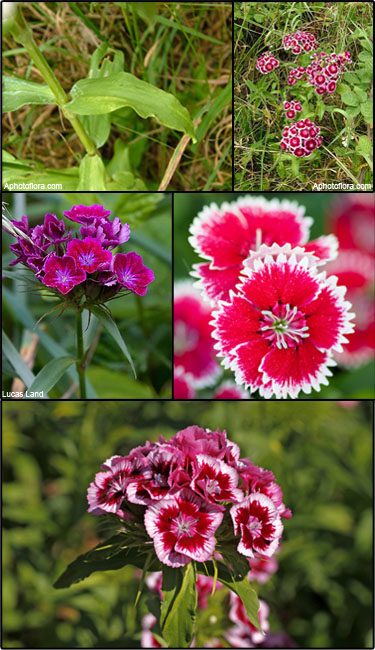Sweetwilliam (Dianthus barbatus)
 Synonyms: Dianthus barbatus L. ssp. barbatus
Synonyms: Dianthus barbatus L. ssp. barbatusCommon Names: sweet william
Description: Introduced to North America as an ornamental.
Habit: Perennial, 12-24 in tall, stout, hairless forb.
Leaves: Opposite, lanceolate, elliptic or oblong, 8 cm long and 2 cm wide, glabrous, sessile to short-petiolate, entire or minutely ciliate.
Stems: 0.75 m tall, glabrous, herbaceous, typically simple but sometimes branching above, 4-angled (the angles rounded).
Flowers: 5 petals, clawed, variously colored, fringed, 10 stamens, included to slightly exerted, calyx is tubular, striate, 1 cm long; blooms June through August.
Fruit and seeds: Seed pod, many seeded, +/- 1cm long.
Habitat: Native to Europe. Prefers deep, organically rich, well-drained soils in full sun.
Reproduction: By seed or division.
Similar species: Wild blue phlox (Phlox divaricata); Downy phlox (Phlox pilosa); and Fall phlox (Phlox paniculata).
Monitoring and rapid response: Cut and hand-pull when flowers begin to fade and die. Credits: The information provided in this factsheet was gathered from Missouriplants.com, the Robert W. Freckmann Herbarium and the USDA PLANTS Database.
Individual species images that appear with a number in a black box are courtesy of the Bugwood.org network (http://www.invasive.org).Individual photo author credits may not be included due to the small display size of the images and subsequent difficulty of reading the provided text. All other images appear courtesy of Google (http://images.google.com).
Common Name: | Sweetwilliam |
Scientific Name: | Dianthus barbatus |
Family: | Caryophyllaceae (Pink) |
Duration: | Perennial |
Habit: | Herbs |
USDA Symbol: | DIBA |
